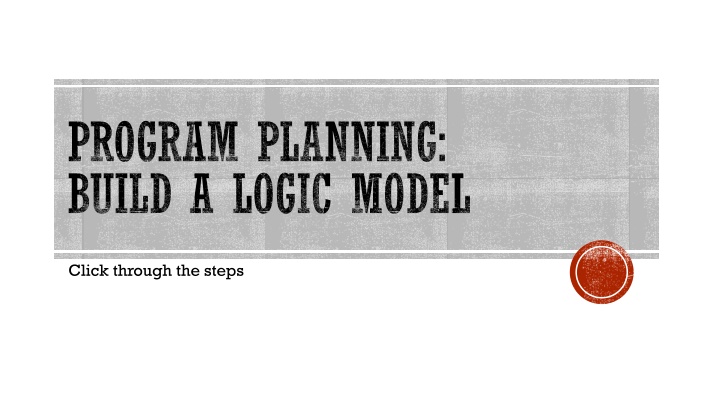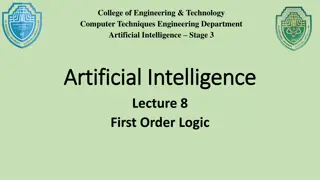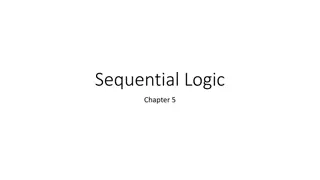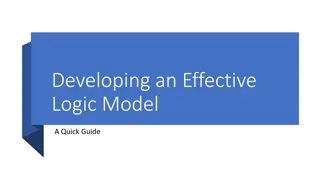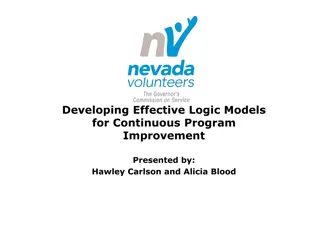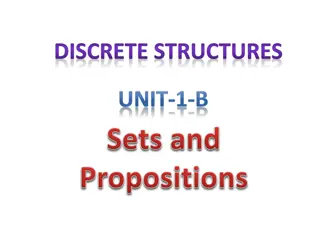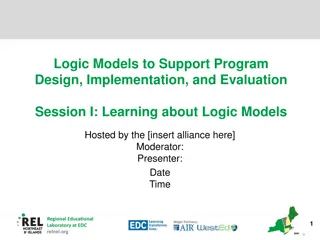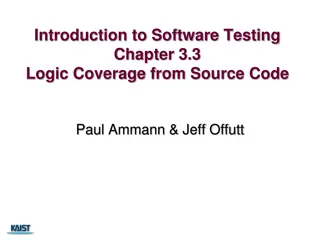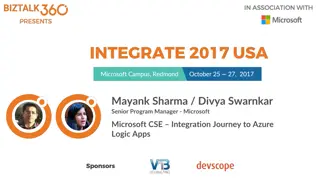Building a Logic Model for Effective Program Planning
A logic model serves as a vital framework in program planning, linking activities to outcomes and goals. By following structured steps like defining goals, determining outcomes, and outlining activities based on best practices, organizations ensure that their programs align with intended objectives and have a meaningful impact. This comprehensive guide breaks down the process into manageable steps, helping program planners create cohesive logic models that validate program theories and drive success.
Download Presentation

Please find below an Image/Link to download the presentation.
The content on the website is provided AS IS for your information and personal use only. It may not be sold, licensed, or shared on other websites without obtaining consent from the author.If you encounter any issues during the download, it is possible that the publisher has removed the file from their server.
You are allowed to download the files provided on this website for personal or commercial use, subject to the condition that they are used lawfully. All files are the property of their respective owners.
The content on the website is provided AS IS for your information and personal use only. It may not be sold, licensed, or shared on other websites without obtaining consent from the author.
E N D
Presentation Transcript
PROGRAM PLANNING: BUILD A LOGIC MODEL Click through the steps
WHY BUILD A LOGIC MODEL? A logic model provides a framework for linking program activities with outcomes and goals. It helps you answer the question: Do these program activities lead to the desired outcomes and goals? The framework helps test if the program theory is accurate if the program activities make sense.
PROGRAM THEORY - LOGIC MODEL Impact/Goal: Youth self-efficacy Independence Work readiness Life skills Outputs: # Sessions # Projects Length of involvement # Youth involved Inputs: Outcomes: Knowledge Commitment Skills Intentions Activities Group activities Community projects Excursions/Field trips Staff experience Staff training Curriculum Setting
STEP 1 - GOAL Start with the end (goal) in mind and work backwards: Example: Young people (14-16 years of age) in my community (town, neighborhood) are able to apply for and hold down summer jobs. What is the goal? Who will benefit from it? What is the priority population?
STEP 2 - OUTCOMES Determine the competencies and behaviors that young people need to meet this goal. Example: Knowledge of work ethics Communication and social skills What are the knowledge areas, skill sets, qualities, intentions we want to see? Interview skills Self-efficacy
STEP 3 - ACTIVITIES Think about what you know about research and best practices to determine your intervention or program activities. What type of programming will lead to the desired behavior? Think about content/curriculum, learning strategies such as experiential learning, group learning, and role plays. Consider the length and frequency of program activities. Example: Work Readiness Program The program will include activities to explore young people s interests/talents and jobs for youth in the community. It will give young people opportunities to practice communication, social, and problem- solving skills (role play, scenarios) and engage them in resume writing and interview skills practice. It may involve facilitating a job placement in the summer. 6-month program, meeting twice a week (ends beginning of summer).
STEP 3 - PART 2 Based on the best practices you identified you can determine the type and number of activities you will offer. Example: 6-month program, 1-hour sessions twice a week (January through June): # of sessions on exploration of individual interests/talents and available jobs # of sessions on workplace ethics (guest speakers) # of sessions on communication in the workplace # of sessions on social and problem-solving skills One month of job shadowing # of sessions on resume writing, completing application forms # of sessions on interview practice
STEP 4 - INPUTS Think about your own capacity and what s needed in terms of resources and staff to do the program. What is our staff and agency capacity? Do we have curricula/resources/ activity material? Do we need training? Do we have community partners we can collaborate with? Depending on your internal resources you may need to adjust scope of the program.
STEP 5 - OUTPUTS Finally, we want to think about how we can measure what we do. This will help determine if we are moving in the right direction, or if we have to make adjustments in our programming. Outputs: Number of sessions Type of sessions Length of session Are we reaching the number of youth we want to reach? Frequency of sessions Number of youth attending Are we delivering all the program components? Are young people staying engaged?
WORK READINESS PROGRAM DOES IT MAKE SENSE? Outcomes: Knowledge of workplace ethics Skill sets gained: Communication, social, problem- solving, resume writing, interview skills Outputs: # Sessions Length of involvement # Job shadowing placements # Youth involved Impact/Goal: Youth self-efficacy Work readiness skills Summer employment Inputs: Activities 6-month program: Group activities Job shadowing Guest speakers Staff experience Staff training Curriculum Community partners
RESOURCES Community Tool Box: Developing a Framework or Model of Change https://ctb.ku.edu/en/4-developing-framework-or-model-change University of Wisconsin-Madison, Division of Extension: Logic Models https://fyi.extension.wisc.edu/programdevelopment/logic-models/
